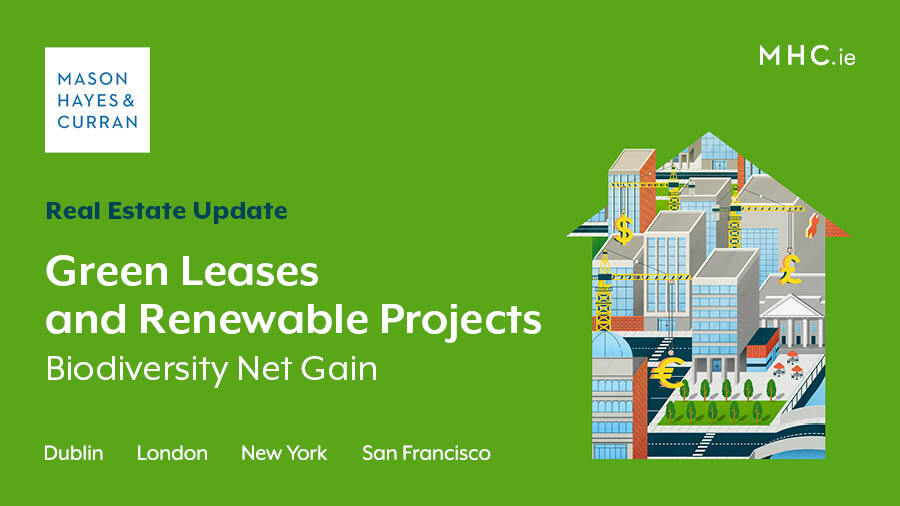
The urgency of addressing climate change is becoming more acute. Ireland is currently striving to reduce its carbon footprint through renewable energy projects. Our Real Estate team explains why it is essential to strike a balance between these initiatives and preserving the country's rich biodiversity.
Just 10 years ago, ESG factors were not given much consideration when reviewing or drafting a property lease. Most companies did not have an ESG policy which could be used as a lens through which to view a lease contract. Indeed environmental regulation for buildings was not overly onerous or a particular focus.
Onset of climate change
Climate change has forced a shift in emphasis. ESG policies are now not only the norm, they are actually driving positive changes through a host of building requirements including the covenants and obligations set out in commercial leases. The recognition of the impact of the construction of new buildings and infrastructure in terms of carbon footprint are now fully appreciated. Environmental regulations emerging from the EU and other legislators requires the futureproofing of leases to address the requirements of these regulations. Careful consideration has to be given to a wave of new regulations which will come to pass during the lifecycle of the lease.
Office leases
When comes to an office lease, the environmental issues to be considered have become well established. The initial construction of the building will produce emissions and carbon will be embodied. A tenant may seek to positively impact those effects by providing for certain construction methods and material requirements in contractual form via an agreement for lease. Once the building is constructed, there are many operational provisions that can be included in a lease. These provisions can range from cooperation between the landlord and tenant on the environmental performance of the building, data recording of the buildings ratings, and environmental credentials. They can also extend to more onerous obligations requiring the parties to take positive steps to achieve net zero performance. Of course, all of these operational provisions come at a cost.
Renewable energy leases
The “green lease” considerations which could apply to renewable energy leases are less obvious. Renewable projects are already highly compliant with environmental laws and contribute significantly to decarbonisation. Indeed, much of the project infrastructure is built underground, with low impact to the environment and other users of the local area. Yet the stakeholders involved in constructing renewable projects will have ESG policies which strive to do even more.
Biodiversity net gain
In order to make the maximum contribution to a sustainable future and land management, many renewable energy companies have committed to making a biodiversity net gain in their ESG policies. Biodiversity net gain involves ensuring that development projects have a positive impact on a habitat’s biodiversity. Ultimately, this ensures that the natural environment is left in a better state than before the project commenced. This allows renewable developers to simultaneously help Ireland meet its climate goals in terms of delivering renewable energy, and also to enhance its natural landscapes and habitats in terms of biodiversity.
For instance, renewable project operators may implement measures such as:
- Planting native vegetation
- Creating buffer zones, and
- Monitoring bird and bat populations
Unlike an office type lease where the green clauses will often be landlord or investor led, with a renewable energy lease, the tenant will be the party seeking to include specific clauses. Some of those clauses would allow the developer or operator to implement biodiversity and conservation measures. Other important clauses would allow the tenant to exclude other parties from those designated lands, thereby helping to protect and maintain existing ecosystems for the duration of the project.
The lands required to implement biodiversity habitats will need to be suitable, allowing a developer to implement the measures to their fullest potential. The lease for this part of the renewable project will need to be bespoke to the biodiversity designated lands and in that way different to a normal renewable land lease. These leases will require a degree of collaboration between all stakeholders to ensure a biodiversity net gain can be achieved and maximised.
Comment
Ireland's journey toward a sustainable future means that every aspect of our lives and how we use, affect and benefit the environment must be considered. This can be clearly seen in the case of buildings that are under construction, and those that use energy and resources. However, it is also a valid consideration that can be given to projects that are producing clean energy in nature-rich locations, and as a result further align with a company’s ESG policy.
Our Real Estate and Planning & Environment teams can help advise and answer queries on these and other matters in the sector.
The content of this article is provided for information purposes only and does not constitute legal or other advice.
Share this:






